Cascadia Research will be undertaking a field project in Hawai‘i from April 8-21, 2010. This work is funded by a number of different sources: the Pacific Islands Fisheries Science Center, the Southwest Fisheries Science Center (with support from the U.S. Navy, N45), and the Alaska SeaLife Center/University of Alaska Fairbanks (with support from the Office of Naval Research). The research team includes Greg Schorr, Daniel Webster and Robin Baird of Cascadia, Dan McSweeney of the Wild Whale Research Foundation, Russ Andrews of the Alaska SeaLife Center/University of Alaska Fairbanks, and a number of volunteers. Our primary goals for this project are to examine movement patterns and habitat use of false killer whales and beaked whales (through the deployment of satellite tags), and to deploy physiological (ECG) tags on short-finned pilot whales.
Like all of our field projects, we also have a number of additional goals:
- Collection of blubber samples from biopsies of false killer whales and other species, for a collaborative study on persistent organic pollutants of these species, with the Northwest Fisheries Science Center.
- Recover and re-deploy a High-frequency Acoustic Recording Package (HARP), used to monitor presence of cetaceans off Kona by recording species-specific sounds.
- Collection of skin/blubber samples from biopsies and from suction-cups for examination of stock structure (in collaboration with Susan Chivers and Karen Martien of the Southwest Fisheries Science Center, and Sarah Courbis of Portland State University) and trophic ecology (in collaboration with Jason Turner of the University of Hawai‘i, Hilo)
- Collection of fecal samples to examine diet (a collaborative project with Mike Ford of the Northwest Fisheries Science Center, Seattle)
- Photo-identification of 10 species of odontocetes to examine residency/movements
- Collection of survey and sighting data for examination of habitat use
- Collecting dead cephalopods to assess potential prey of deep-diving odontocetes, in collaboration with Bill Walker at the National Marine Mammal Laboratory
- Collection of sighting information and photographs of sea birds
For more information see our Hawai‘i odontocete research page
Most recent updates are at the top of the page.
Sign up to our Facebook page if you want to receive updates from future projects.
Recent movements of the satellite tagged sperm whale

Although our field project ended last week we are still getting location data from the satellite tagged sperm whale and Cuvier’s beaked whale. The map above shows 10 days of movements of the sperm whale, from April 15-25, 2010. The satellite-derived locations have not been filtered to eliminate unrealistic locations (based on travel speed) and locations may change after additional post-processing by ARGOS.
End of project update

Melon-headed whale off Kona, April 12, 2010. Photo by Greg Schorr.
This field effort was the start of Cascadia’s 8th year of Hawai‘i odontocete research, as part of an ongoing (11-years and counting) study. As with most of our field projects in Hawai‘i, our accomplishments include a slow accumulation of photographs, samples for genetics and toxicology, and habitat use data of the many species of odontocetes we encounter, combined with a couple of particularly good days when we have more major accomplishments, that rapidly change the way we think about or what we know about one or two species. This trip we covered almost 2,000 kilometers of survey trackline, had 45 encounters with 11 species, took over 16,000 photos, and collected 14 samples for genetics and toxicology. We also had two of those “major accomplishment” days. On April 11th we satellite tagged a sperm whale, and movement data from that individual is still coming in (see below for maps and details). On April 19 we deployed a satellite/dive tag on a Cuvier’s beaked whale, the first such tag deployed on a beaked whale, and we are continuing to obtain both movement and dive data from that individual. Despite it being the 11th year of our research in Hawai‘i, we are still learning new things and these two days will change what we know about these two species in Hawaiian waters.
Our next field effort in Hawai‘i will probably not be until September or October of this year. Sign up to our Facebook page if you want to receive updates from future projects.
April 21, 2010 update
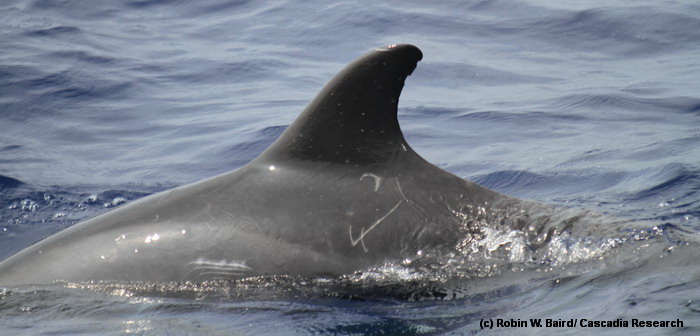
A pygmy killer whale, April 21, 2010. Photo by Robin Baird. Our 11th species of odontocete for the trip, a group of about nine pygmy killer whales. We were able to get good identification photos of all the individuals and one sample for genetics and toxicology. For more information on pygmy killer whales see our page for this species.
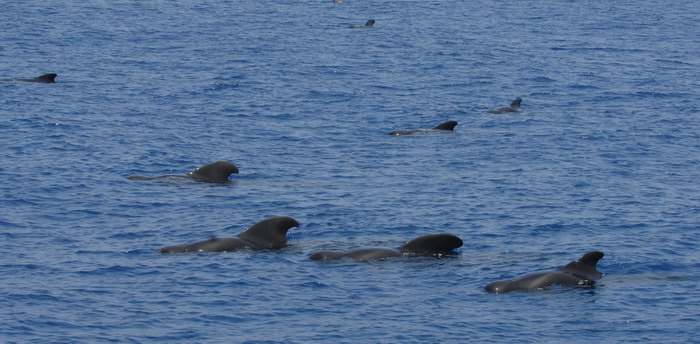
Short-finned pilot whales, April 21, 2010. Photo by Russ Andrews. We also encountered three groups of short-finned pilot whales, and were able to deploy another ECG tag. AS of the morning of April 22nd the tag is still out there and we are hoping to recover it today.
April 20, 2010 update
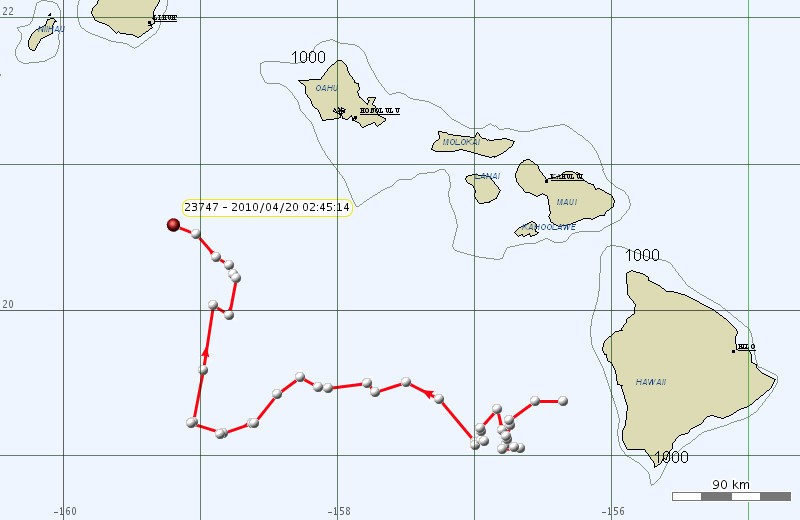
Movements of the satellite-tagged sperm whale through the morning of April 20, 2010.
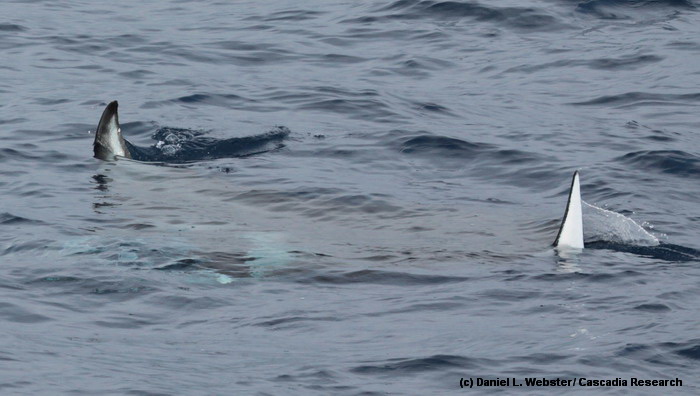
Manta off Kona, April 20, 2010. Photo by Daniel Webster. Another 160 kilometers on the water today. We re-deployed the HARP, and also spotted a distant breaching beaked whale, but otherwise the highlights of today were non-marine mammal wildlife.
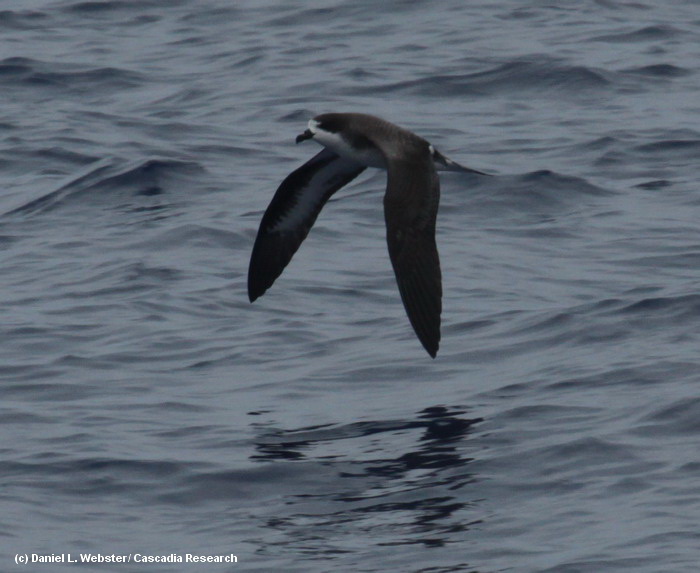
Hawaiian petrel, April 20, 2010. Photo by Daniel Webster.
April 19, 2010 update
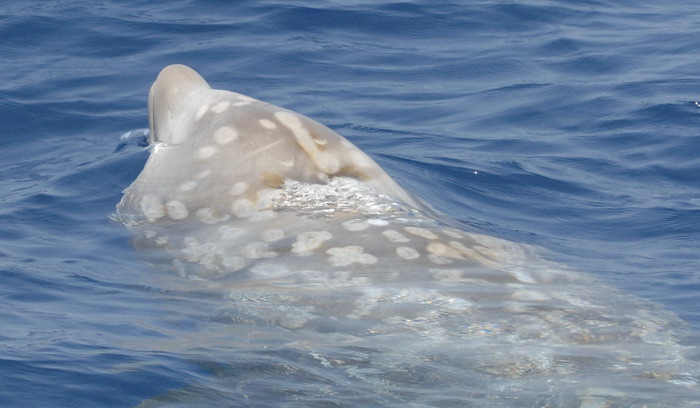
An adult female Cuvier’s beaked whale, April 19, 2010. Photo by Russ Andrews. Another 162 kilometers on the water with only one sighting, but this time an adult female Cuvier’s beaked whale. We deployed a Wildlife Computers Mk10a satellite-dive tag, the first satellite-dive tag ever deployed on a beaked whale. We are getting locations and dive data coming in from the ARGOS satellite system.
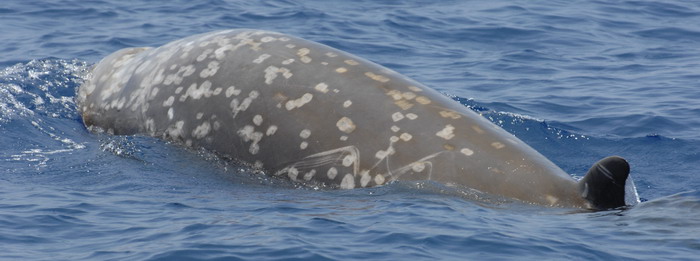
Adult female Cuvier’s beaked whale off Kona, April 19, 2010. Photo by Russ Andrews. We were able to identify this individual as an adult female by the lack of erupted teeth in the lower jaw, the extensive scarring from cookie-cutter sharks, and the lack of extensive linear scars (see our beaked whale page for more information).
April 18, 2010 update
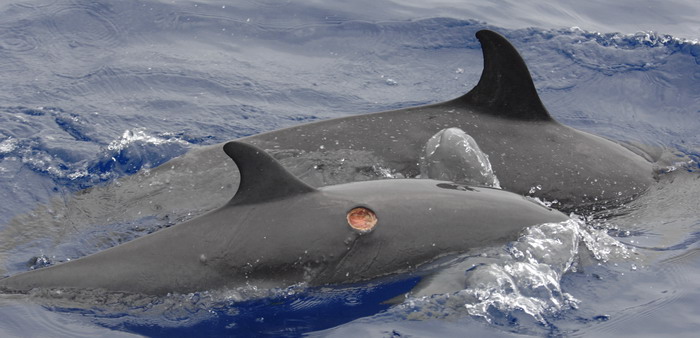
Pantropical spotted dolphin with bite wound from a cookie-cutter shark, April 18, 2010. Photo by Russ Andrews. Although we covered 173 kilometers today in relatively good conditions (more than 120 kilometers in Beaufort 1 or 2), but our only cetacean sightings were pantropical spotted dolphins and spinner dolphins.
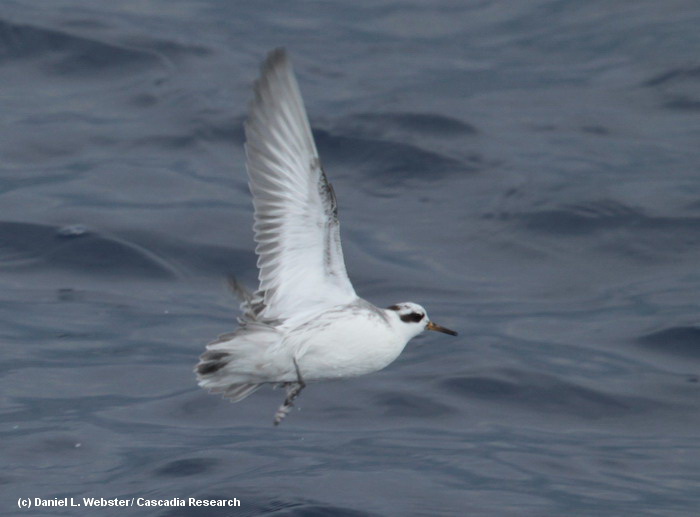
Phalarope, off Kona, April 18, 2010. Photo by Daniel Webster.
April 17, 2010 update
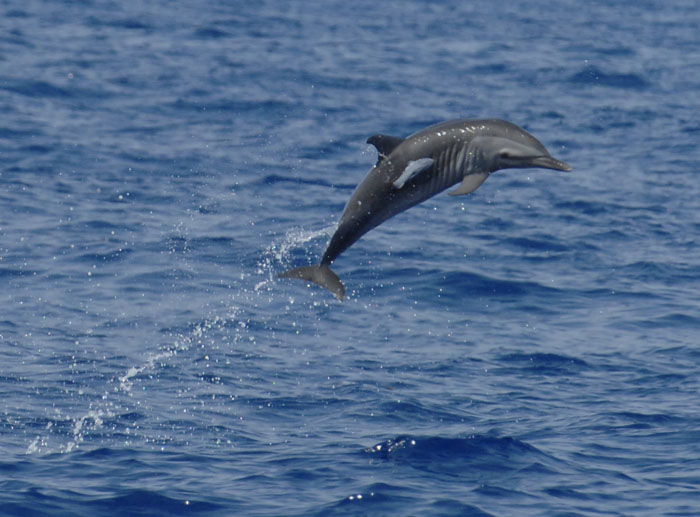
Leaping juvenile pantropical spotted dolphin with remora, April 17, 2010. Photo by Russ Andrews.
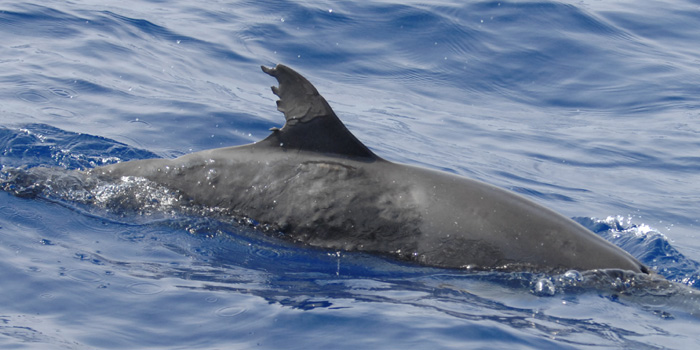
A well-marked pantropical spotted dolphin with skin lesions below dorsal fin, April 17, 2010. Photo by Russ Andrews.
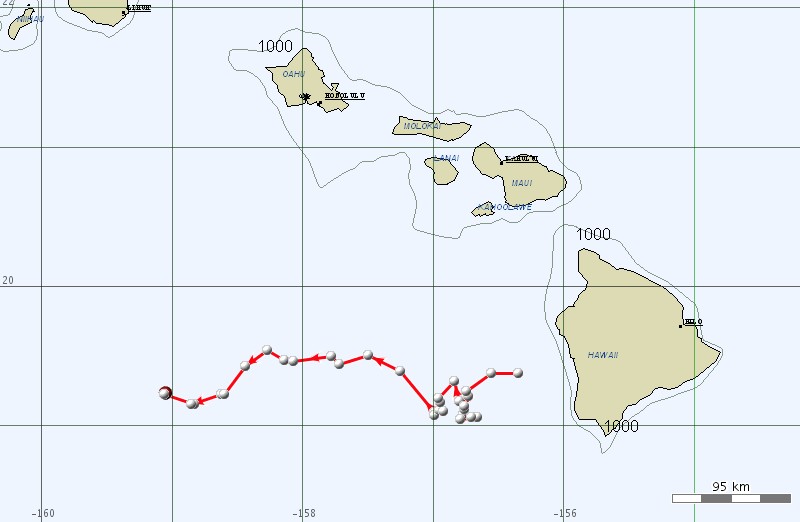
Movements of the satellite tagged sperm whale from April 11 through mid-day April 17, 2010. The satellite-derived locations have not been filtered to eliminate unrealistic locations (based on travel speed) and locations may change after additional post-processing by ARGOS.
April 16, 2010 update
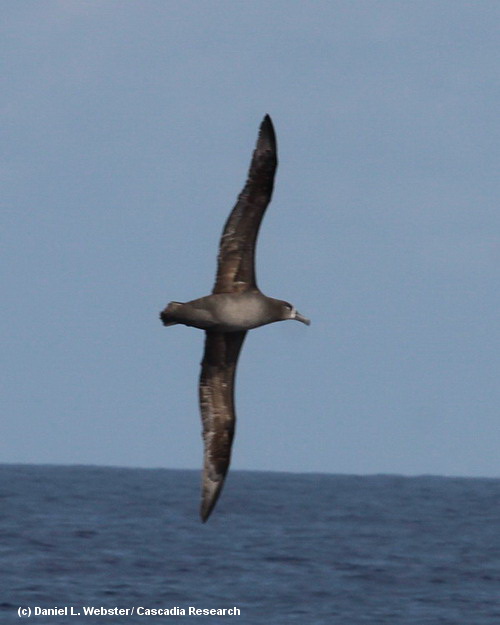
Black-footed albatross, April 16, 2009. Photo by Daniel Webster. Our ninth day on the water today. In our first six days on the water we had 27 sightings of 10 species of odontocetes (including 10 sightings of short-finned pilot whales). In the last three days we’ve had two sightings (one group of spinner dolphins and one group of spotted dolphins). Killer whales were seen in the area a few days ago, perhaps partly responsible for the paucity of sightings?
April 15, 2010 update
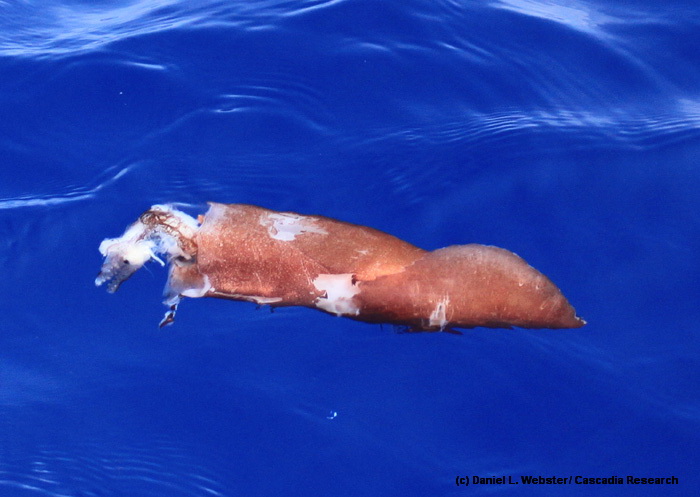
Squid collected April 15, 2010. Photo by Daniel Webster. Although we covered 120 kilometers today, most of it in deep water and with good sighting conditions, the highlight for the day was perhaps collection of our third squid for the trip.

The satellite tagged sperm whale passes over Jaggar Seamount, April 15, 2010. The map above shows four days of movements of the satellite tagged sperm whale. The satellite-derived locations have not been filtered to eliminate unrealistic locations (based on travel speed) and locations may change after additional post-processing by ARGOS.
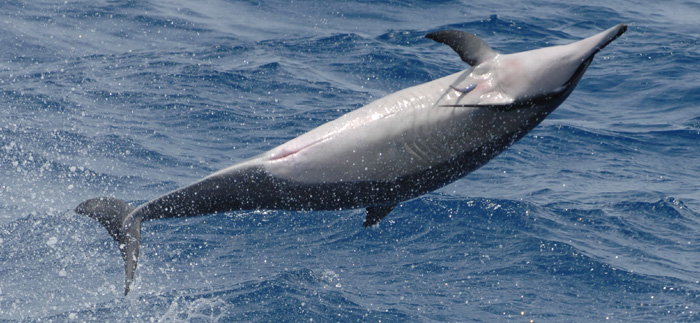
A spinner dolphin spinning, possibly to try to remove the small remora visible between the pectoral flippers, April 15, 2010. Photo by Russ Andrews.
April 14, 2010 update

Deploying an ECG tag on a short-finned pilot whale, April 13, 2010. Photo by Robin Baird. Yesterday we deployed a short-term ECG (electrocardiogram) tag on a pilot whale, as part of a collaborative project to study diving physiology with Russ Andrews of the Alaska SeaLife Center/University of Alaska Fairbanks. To help recover the tag it had both a VHF radio transmitter and a satellite transmitter on-board – we knew the tag came off this morning just after 5 AM by monitoring the satellite data, and we were able to recover the tag before 8 AM using the VHF transmitter.
April 13, 2010 update
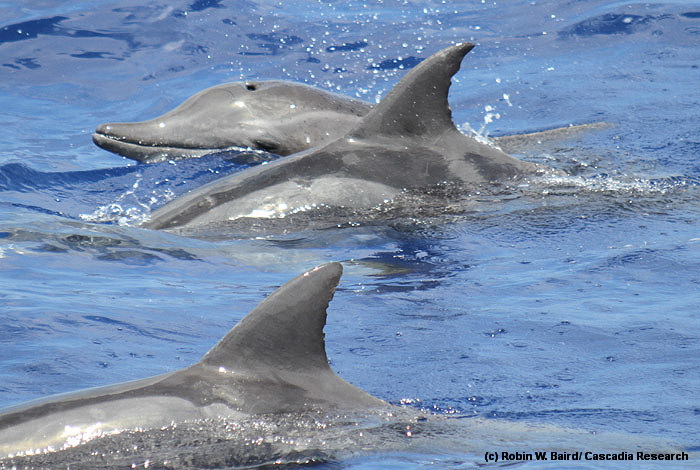
Rough-toothed dolphins, April 13, 2010. Photo by Robin Baird. A busy day today, encounters with three groups of pilot whales, two groups of spotted dolphins, and a group of rough-toothed dolphins.
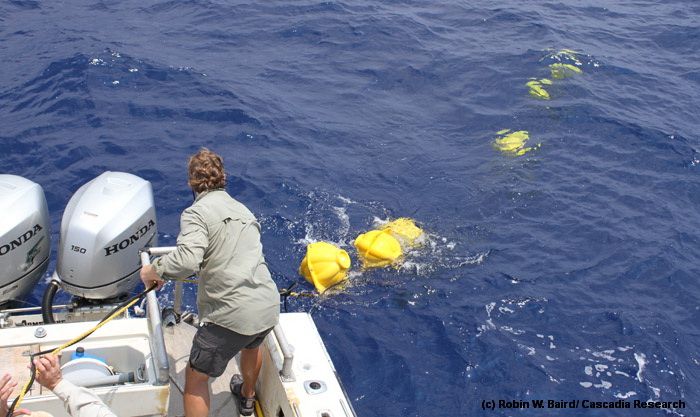
Recovering the HARP (High-frequency Acoustic Recording Package), April 13, 2010. Photo by Robin Baird. This HARP has been deployed since our December 2009 project, recording most species of cetaceans as they’ve moved along the Kona coast.
April 12, 2010 update
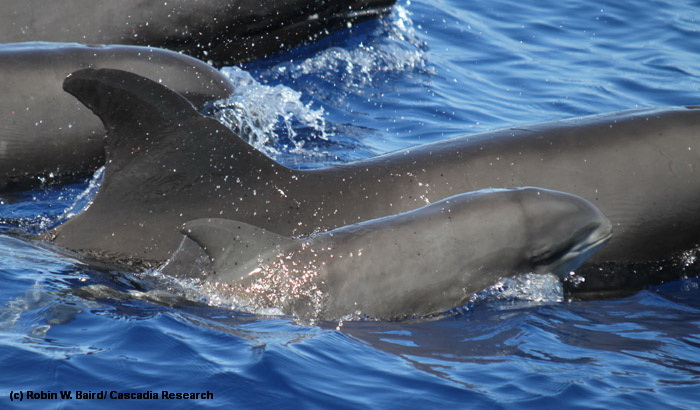
Melon-headed whale mother and infant, April 12, 2010. Photo by Robin Baird.
Another good day on the water. We encountered our eighth (spinner dolphins), ninth (melon-headed whales) and tenth (bottlenose dolphins) species of odontocetes for the trip – 10 species in 5 days, perhaps a new record for our work. The melon-headed whale group contained about 145 individuals, including at least three very small calves (with fetal folds).

Melon-headed whale with distinctive dorsal fin, April 12, 2010. Photo by Daniel Webster. We were able to photo-identify many of the individuals present. Work by Jessica Aschettino at Hawai‘i Pacific University, using photos we’ve been collecting since 2002, is showing the presence of two populations in Hawaiian waters – the well marked individual above is HIPe1521 in our catalog, and the mother in the top photo is HIPe0665, both individuals from the Big Island ‘resident’ population.

One day of movements of a satellite-tagged sperm whale. See below for details.
April 11, 2010 update
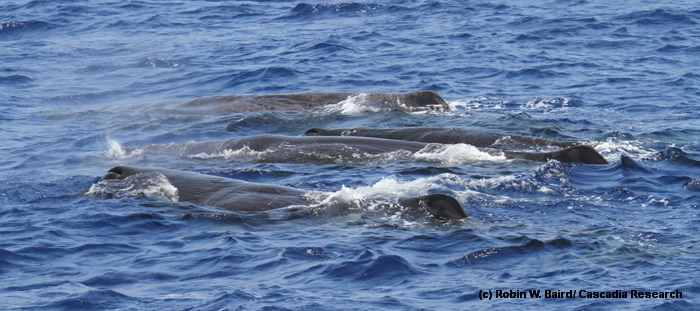
Sperm whales off Kona, April 11, 2010. Photo by Robin Baird.
Our fourth day on the water for this trip. We covered an area out to about 45 kilometers from shore in water over 4,500 m deep, encountering our fifth, sixth and seventh species of odontocetes for the trip – rough-toothed dolphins, striped dolphins, and sperm whales (as well as encounters with short-finned pilot whales and pantropical spotted dolphins).
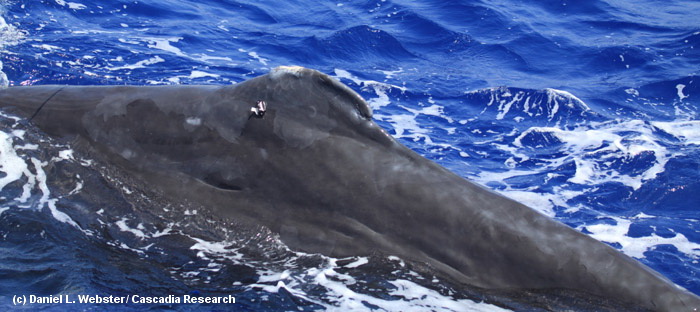
Sperm whale with satellite tag, April 11, 2010. Photo by Daniel Webster. We were able to deploy a satellite tag on one of the sperm whales in the group, to track movements. In the photo above you can see the satellite tag at the base of the dorsal fin. This individual appears to have previously experienced an attack by killer whales, with a series of tooth rakes on the dorsal fin and back immediately in front of the tag. The lighter grey areas of skin in front of, above and behind where the tag is attached are areas were the outer layer of skin has recently sloughed off.

Sperm whale tail-lobbing, April 11, 2010. Photo by Robin Baird
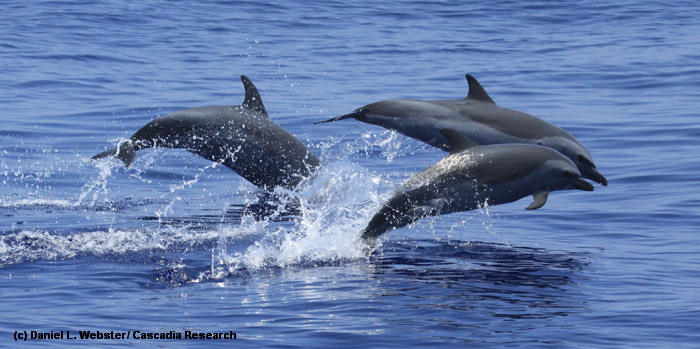
Spotted dolphins porpoising off Kona, April 11, 2010. Photo by Daniel Webster
April 10, 2010 update
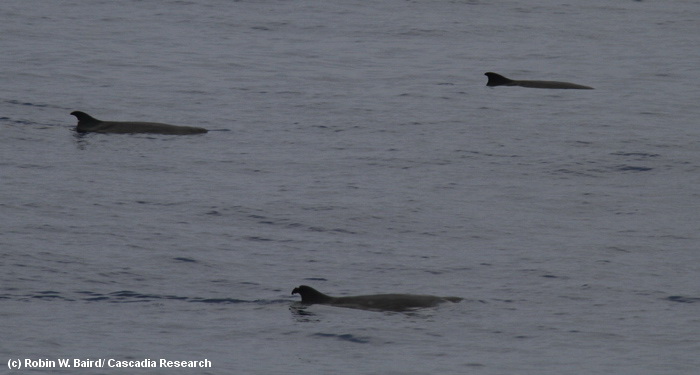
Three dwarf sperm whales off Kona, April 10, 2010. Photo by Robin Baird.
Today we covered 155 kilometers of trackline off the Kona coast, first heading north from the harbor before turning offshore and south as the sea conditions picked up to the north. We encountered two groups of short-finned pilot whales and a group of pantropical spotted dolphins, and were able to photo-identify all the pilot whales and some of the spotted dolphins. The highlight of the day was a group of three dwarf sperm whales. We tracked the group for 25 minutes and photo-identified all three individuals present, then left the group to continue our survey. Two of the three were marked individuals – although our catalog size for this species is small, we have a high re-sighting rate so hope one or more will be in the catalog.

Dwarf sperm whales off Kona, April 10, 2010. Photo by Robin Baird.
April 9, 2010 update
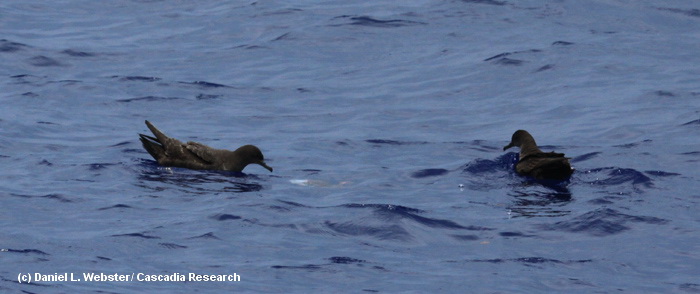
Sooty shearwaters with floating squid, April 9, 2010. Photo by Daniel Webster.
Day 2 on the water for this trip (and this year), we have had two encounters with short-finned pilot whales, one group of pantropical spotted dolphins, one (distant) Cuvier’s beaked whale, and a lot of seabirds. Today we found two floating squid, one being scavenged on by two sooty shearwaters.
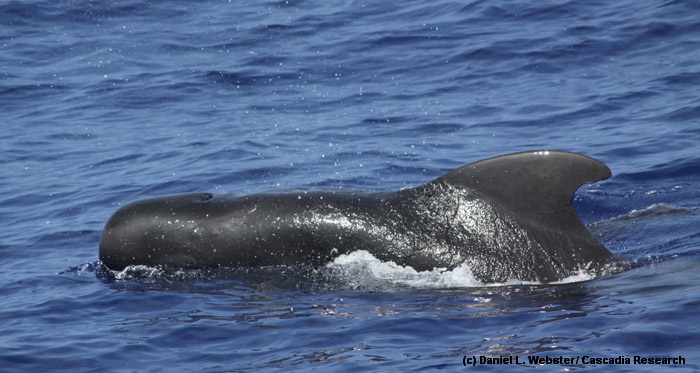
Short-finned pilot whale, April 8, 2010. Photo by Daniel Webster.
Photos on this page taken under NMFS Scientific Research Permits (Nos. 731-1774 and 774-1714). All photos are copyrighted and should not be used without permission.